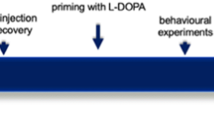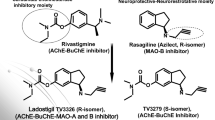Abstract
The importance of monoamine oxidase (MAO) A and B in maintaining the cytoplasmic levels of monoamines (dopamine, noradrenaline, serotonin and phenylethylamine) low within the aminergic neurones and their role in cytoplasmic release mechanism are well established. Animal behavioural and biochemical studies have shown that MAO in the brain is in excess and inhibition of enzyme by more than 80 % is required for amino release into “function”. The alteration in brain concentrations of dopamine and serotonin after L-dopa (L-dihydroxyphenylalamine) and L-tryptophan treatments respectively, are not as obvious as those seen in animals pretreated with selective MAO inhibitors. Therefore, enzyme inhibition and amino acid precursor loading would appear to be obvious and logical choice for treatment of Parkinson’s disease and depressive illness, where alterations in dopamine and serotonin metabolism have been implicated in their pathophysiology. The therapeutic success of 1-deprenyl (MAO-B inhibitor) in combination with L-dopa or L-5-hydroxytryptophan for the management of Parkinson’s disease and depression has manifested itself in the predominance of MAO-B in the extrapyramidal regions and raphe nucleus of human brain. The apparent potentiation of the pharmacological activities of the neurotransmitters, derived from amino acids precursors, by MAO-B inhibitor is supported by the clinical data, since neither treatment alone appears to be as effective. MAO-B is an enzyme capable of oxidizing a variety of primary, secondary and tertiary aliphatic and aromatic monoamines. This property of MAO-B lends itself to the oxidation of inert amines, including the Parkinson inducing compound, MPTP (N-methyl-4-phenyl-1, 2,3,6-tetrahydropridine), and the anticonvulsant, milacemide (2-n-pentylaminoacetamide) to neuroactive metabolites. Precursor amino acid treatment of neurological disorders, where inhibitory neurotransmitters GABA and glycine are implicated have not been successful, since, these amino acids hardly cross the blood brain barrier (BBB). However, the potent glycine-derivative anticonvulsant, milacemide, readily crosses the BBB where it is actively converted to glycineamide, followed by glycine. In vitro and in vivo studies have demonstrated that the major (80–90 %) route of its metabolism is solely mediated by MAO-B and is the only one so far identified in the brain. The oxidation of milacemide is selectively inhibited by MAO-B rather than MAO-A inhibitors. Milacemide, therefore, behaves as a prodrug and opens a new avenue for the development of similar drugs derived from other amino acids. Thus, just as in the case with “dopamine replacement” therapy of Parkinson’s disease by L-dopa, similar therapeutic approaches can be envisaged for the treatment of neurological disorders involving alterations in inhibitory amino acid neurotransmitters.
Access this chapter
Tax calculation will be finalised at checkout
Purchases are for personal use only
Preview
Unable to display preview. Download preview PDF.
Similar content being viewed by others
References
FINBERG, J. P. M., YOUDIM, M. B. H. (1984). Monoamine oxidase. In: Handbook of Neurochemistry (Lajtha, A., ed.), Plenum Press, New York, 4: 293-330.
YOUDIM, M. B. H., FINBERG, J. P. M. (1985). Monoamine oxidase inhibitor antidepressants. In: Psychopharmacology 2/1 (Grahame-Smith, D. G., Hippius, H., Winokur, G., eds.) Excerpta Medica Amsterdam, pp. 35–71
TIPTON, K. F. (1986). Enzymology of monoamine oxidase. Cell Biochem. Function 4: 79-88.
YOUDIM, M. B. H., FINBERG, J. P. M., TIPTON, K. F. (1987b). Monoamine oxidase. In: Catecholamine Il. Handbook of Experimental Pharmacology (Weiner, N., Tredelenburg, U., eds.). Springer-Verlag, Berlin (in press).
MARKEY, S. P., CASTAGNOLI, N. JR., TREVOR, A. J., KOPIN, 1. J. (Eds.) (1986). MPTP: A Neurotoxin Producing a Parkinson Syndrome. Academic Press, New York.
YOUDIM, M. B. H. DE VAREBEKE, P. J., ROBA, J., CAVALIER, R., GILBERT, P. (1987a). Formation of glycine from the novel anticonvulsant milacemide is mediated by brain monoamine oxidase B. In: Epilepsy (Manleis, J., ed.), Raven Press, New York (in press).
DE VAREBEKE, P. J., CAVALIER, R., DAVID-REMAELE, M., YOUDIM, M. B. H. (1987a). Formation of the neurotransmitter glycine from the anticonvulsant milacemide is mediated by brain monoamine oxidase B. J. Neurochem. (in press).
DE VAREBEKE, P. J., CAVALIER, R., DAVID-REMAELE, M., YOUDIM, M. B. H. (1987b). Conversion of the novel anticonvulsant milacemide to glycine in brain is mediated by monoamine oxidase B. 9th Catecholamine Conference (Sandler, M., Dahlstrom, A., Belmaker, H., eds.), Alan R. Liss, New York (in press).
COLLINS, G. G. S., SANDLER, M., WILLIAMS, E. D., YOUDIM, M. B. H. (1970). Multiple forms of human brain mitochondria) monoamine oxidase. Nature 225: 817–820.
YOUDIM, M. B. H., COLLINS, G. G. S., SANDLER, M. (1972). Human brain monoamine oxidases: multiple forms and selective inhibitors. Nature 236: 225–228.
JOHNSTON, J. P. (1968). Some observation upon a new inhibitor of monoamine oxidase in brain tissue. Biochem. Pharmacol. 17: 1285-1297.
BIRKMAYER, W., RIEDERER, P., YOUDIM M B. H., LINAUER, W. (1975). The potentiation of the antiakinetic effect of L-dopa treatment by an inhibitor of MAO-B deprenyl. J. Neural Transm. 36: 303–326.
GREEN, R. A., MITCHELL, D. B., TORDOFF, F. C., YOUDIM, M. B. H. (1977). Evidence of dopamine deamination by both type A and type B monoamine oxidase in rat brain in vivo and for the degree of enzyme inhibition necessary for functional activity of dopamine and 5-hydroxytrypramine. Br. J. Pharmacol. 60: 343-349.
KNOLL, J., MAGYER, K. (1972). Some puzzling effects of monoamine oxidase inhibitors. Adv. Biochem. PsychopharmacoL 5: 393-408.
BIRKMAYER, W., RIEDERER, P., AMBRAZI, L., YOUDIM, M. B. H. (1977). Implications of combined treatment with madopar and I-deprenil in Parkinson’s disease. Lancet i439–444.
LEES, A. J., SHAW, K. M., KOHOUT, L., STERN, G. M., ELSWORTH, J. D., SANDLER, M., YOUDIM, M. B. H. (1977). Deprenyl in Parkinson’s disease. Lancet ii: 791–795.
BIRKMAYER, W., RIEDERER, P., YOUDIM, M. B. H. (1982). (-) Deprenyl in the treatment of Parkinson’s disease. Clin. Neuropharmacol. 5. 195-230.
RINNE, U. K. (ed.) (1983). A new approach to the treatment of Parkinson’s Disease. Acta NeuroL. Scand. SuppL 95 68: 7–144.
YOUDIM, M. B. H. (1986). Pharmacology of MAO-B inhibitors: mode of action of (-) deprenyl in Parkinson’s disease. J. Neural Transm. SuppL 22: 91-106.
YAHR, M. W. (1978). Overview of present day treatment of Parkinson’s disease. J. Neural Transm. 43: 227–238.
RIEDERER, P., YOUDIM, M. B. H. (1986). Brain monoamine oxidase activity and monoamine metabolism in Parkinson patients treated with (-) deprenyl. J. Neurochem. 46: 1359–1365.
GREEN, A. R., YOUDIM, M. B. H. (1975). Effect of Monoamine oxidase inhibition by clorgyline, deprenyl or tranylcypomine on 5-HT concentration in brain and hyperactivity following subsequent tryptophan administration. Br. J. PharmacoL 55: 415-422.
YOUDIM, M. B. H., ASHKENAZI, R. (1982). Regulation of 5-HT catabolism. In: Serotonin in Biological Psychiatry ( Schooler, J. C., Usdin, E., eds. B. T. H. O.), Raven Press, New York, pp. 35–60.
O’CARROL, A. M., FOWLER, C., PHILLIPS, J. P., TOBIA, I., TIPTON, K. F. (1983). The deamination of dopamine by human brain monoamine oxidase. Arch. PharmacoL 322: 198-222.
RIEDERER, P., KONRAD!, C., SCHAY, V., KIENTL, E., BIRKMAYER, W., DANIELCZYK, W., YOUDIM, M. B. H. (1986). Localization of MAO-A and MAO-B in human brain. A step in understanding the therapeutic action of I-deprenyl. Adv. Neurot. 43: 111-118.
BEVAN JONES, A. B., PARE, C. M. B., NICHOLSON, W. J., PRICE, K., STACEY, R. S. (1972). Brain amine concentrations after MAO inhibitor administration. Br. Med. J. 1: 17-19.
MELDRUM, B. S. (1986). Drugs acting on amino acid neurotransmitters. Adv. NeuroL 43: 687-706.
ROBA, J., CAVALIER, R., CORDI, A., GORISEN, H., HERIN, M., DE VARBEKE, P. J. (1986). Milacemide. In: New Anticonvulsant Drugs ( Meldrum, B. S., Porter, H. H., eds.), J. Libbey and Co., London, pp. 179–180.
KALIR, A., SABBACH, A., YOUDIM, M. B. H. (1981). Selective acetylenic “suicide” and reversible inhibitors of monoamine oxidase type A and type B. Br. J. Pharmacol. 73: 55-64.
SUZUKI, O., YOSHIANAO, K., OYA, M. (1979). Characterization of some biogenic monoamines as substrates of type A and type B monoamine oxidase. In: Monoamine Oxidase Structure, Function and Altered Functions ( Singer, T. P., Von Korff, R. W., Murphy, D. L., eds.), Academic Press, New York, pp. 197–204.
SEILER, N., AL-THERIB, M. J. (1974). Puterescine catabolism in mammalian brain. Biochem. J. 144: 29-35.
NOTO, T., HASHIMOTO, H., NAKAO, J., KAMINURA, H., NAKAJIMA, T. (1986). Spontaneous release of GABA formed from putrescine and its enhanced CA2`-dependent release by high K. stimulation in the brains of freely moving rats. j. Neurochem. 46: 1877–1880.
HOUTKOOPR, M. A., OORSHOL, C. A. E. H., RENTNEESTER, T. W., HOEPPENER, P. S. E. A., ONKELINX, C. (1986). Double blind study of milacemide in hospitalized therapy-resistant patients with epilepsy. Epilepsia 27: 255–262.
YOUDIM, M. B. H., KEREM, D., DUVDOVAN, Y. (1987c). L-Deprenyl reverses the increase of seizure threshold induced by milacemide in hyperbar is oxygen toxicity. Eur. J. Pharmacol. ( Submitted).
FAHN, S., MARSDEN, C. D., VAN WOERT, M. (eds.) (1986). Myoclonus.Adv. Neurol. 43: Raven Press, New York.
PRATT, J. A., ROTHWELL, J., JENNER, P., MARSDEN, C. D. (1986). P,P’-DDT-induced myoclonus in the rat and its application as an animal model of 5-HT-sensitive action myoclonus. Adv. Neurol. 43: 577-588.
CARLSSON, A. (1974). The in vivo estimation of rated of tryptophan and tyrosine hydroxylation: effect of alterations in enzyme environment and neuronal activity. In: Aromatic Amino Acids in the Brain. Ciba Foundation Symposium 22 ( New Series), Elsevier, Amsterdam, pp. 117–134.
CHUNG HWANG, E., VAN WOERT, M. (1978). P,P’-DDT-induced neurotoxic syndrome experimental myoclonus. Neurology 28: 1020–1025.
JOHNSON, J. W., ASCHER, P. (1981). Glycine potentiates the NMDA response in cultured mouse brain neurons. Nature 325: 522–525.
BIRKMAYER, W., KNOLL, J., RIEDERER, P., YOUDIM, M. B. H. (1983). (-) Deprenyl leads to prolongation of L-dopa efficacy in Parkinson’s disease. Mol. Probl. Pharmaco-Psychiatry 19: 170-177.
BIRKMAYER, W., KNOLL, J., RIEDERER, P., YOUDIM, M. B. H., HARS, V., MARTON, H. (1985). Increased life expectancy resulting from addition of 1-deprenyl to madopar treatment of Parkinson’s disease. A long term study. J. Neural. Trans. 64: 113-117.
Author information
Authors and Affiliations
Editor information
Editors and Affiliations
Rights and permissions
Copyright information
© 1988 Springer-Verlag Berlin Heidelberg
About this paper
Cite this paper
Youdim, M.B.H., Riederer, P. (1988). Brain Monoamine Oxidase B Activity and Amino Acid Precursor Treatment of Parkinson’s Disease, Depression and Epilepsy. In: Huether, G. (eds) Amino Acid Availability and Brain Function in Health and Disease. NATO ASI Series, vol 20. Springer, Berlin, Heidelberg. https://doi.org/10.1007/978-3-642-73175-4_34
Download citation
DOI: https://doi.org/10.1007/978-3-642-73175-4_34
Publisher Name: Springer, Berlin, Heidelberg
Print ISBN: 978-3-642-73177-8
Online ISBN: 978-3-642-73175-4
eBook Packages: Springer Book Archive




